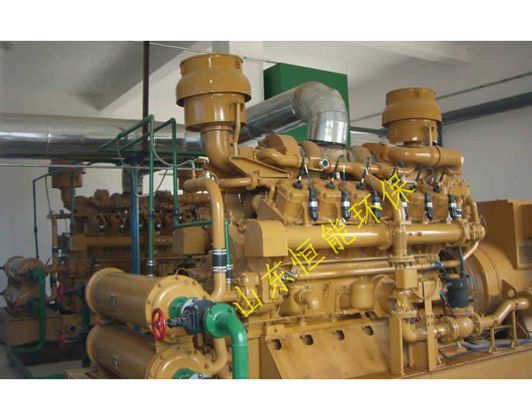欢迎进入山东恒能环保能源设备有限公司
欢迎进入山东恒能环保能源设备有限公司
干发脱硫是一种简易、、相对低成本的脱硫方式,一般适合用于沼气量小,硫化氢浓度低的沼气脱硫。干法脱除沼气气体中硫化氢(H2S)的设备基本原理是以O2使H2S氧化成硫或硫氧化物的一种方法,也可称为干式氧化法。干法设备的构成是,在一个容器内放入填料,填料层有活性炭、氧化铁等。气体以低流速从一端经过容器内填料层,硫化氢(H2S)氧化成硫或硫氧化物后,余留在填料层中,净化后气体从容器另一端排出。干式脱硫主要包括主体钢结构、脱硫剂填料、观察窗、压力表、温度表等组件。
Dry flue gas desulfurization is a simple, efficient, and relatively low-cost desulfurization method, generally suitable for biogas desulfurization with small biogas volume and low hydrogen sulfide concentration. The basic principle of the equipment for dry removal of hydrogen sulfide (H2S) from biogas gas is a method of using O2 to oxidize H2S into sulfur or sulfur oxides, also known as dry oxidation method. The composition of dry process equipment is to place fillers in a container, and the filler layer includes activated carbon, iron oxide, etc. The gas passes through the packing layer inside the container at a low flow rate, and hydrogen sulfide (H2S) is oxidized to sulfur or sulfur oxides, remaining in the packing layer. After purification, the gas is discharged from the other end of the container. Dry desulfurization mainly includes components such as main steel structure, desulfurizer filler, observation window, pressure gauge, temperature gauge, etc.
脱硫塔通常设计为一用一备,交替使用,即一个脱硫,一个再生。含有硫化氢(H2S)的沼气进入脱硫塔底部,在穿过脱硫填料层到达顶端的过程中,H2S与脱硫剂发生以下的化学反应:步:Fe2O3·H2O+3H2S=Fe2S3+4H2O(脱硫)第二步:Fe2S3+3/2O2+3H2O=Fe2O3·H2O+2H2O+3S(再生)含有硫化氢的沼气与底部入口处荷载相对高的脱硫剂反应,反应器上部是负载低的脱硫剂层,通过设计良好的沼气空速和线速,干式脱硫能到达良好的精脱硫效果。在沼气进入干式脱硫塔之前,应设置有冷凝水罐或沼气颗粒过滤器。该装置可以沼气中夹杂的颗粒杂志,并使得沼气在进入脱硫前含有一定湿度。当观察到脱硫剂变色,或系统压力损失过大时,应交替使用另一个脱硫塔。当前的脱硫塔在沼气放空后,进行自然通风,对脱硫剂进行再生。当再生效果不佳时,应从塔体底部将废弃的脱硫剂排除,在底部排放废弃填料的同时,相同体积的新鲜脱硫填料加入反应器中。湿法脱硫可以归纳分为物理吸收法、化学吸收法和氧化法三种。

Desulfurization towers are usually designed as one for use and one for backup, alternating between one for desulfurization and one for regeneration. Biogas containing hydrogen sulfide (H2S) enters the bottom of the desulfurization tower. During the process of passing through the desulfurization filler layer and reaching the top, H2S undergoes the following chemical reaction with the desulfurizer: Step 1: Fe2O3 · H2O+3H2S=Fe2S3+4H2O (desulfurization) Step 2: Fe2S3+3/2O2+3H2O=Fe2O3 · H2O+2H2O+3S (regeneration) Biogas containing hydrogen sulfide first reacts with the desulfurizer with a relatively high load at the bottom inlet. The upper part of the reactor is a low load desulfurizer layer. Through well-designed biogas airspeed and linear velocity, dry desulfurization can achieve good precision desulfurization effect. Before biogas enters the dry desulfurization tower, a condensate tank or biogas particle filter should be installed. This device can eliminate particle magazines mixed in biogas and make biogas contain a certain humidity before entering desulfurization. When discoloration of the desulfurizer or excessive pressure loss in the system is observed, another desulfurization tower should be used alternately. The current desulfurization tower undergoes natural ventilation after releasing biogas to regenerate the desulfurizer. When the regeneration effect is poor, the waste desulfurizer should be discharged from the bottom of the tower. At the same time as the waste packing is discharged at the bottom, fresh desulfurized packing of the same volume should be added to the reactor. Wet desulfurization can be classified into three types: physical absorption method, chemical absorption method, and oxidation method.
物理和化学方法存在硫化氢再处理问题,氧化法是以碱性溶液为吸收剂,并加入载氧体为催化剂,吸收H2S,并将其氧化成单质硫,湿法氧化法是把脱硫剂溶解在水中,液体进入设备,与沼气混合,沼气中的硫化氢(H2S)与液体产生氧化反应,生成单质硫吸收硫化氢的液体有氢氧化钠、氢氧化钙、碳酸钠、硫酸亚铁等。成熟的氧化脱硫法,脱硫效率可达99.5%以上。在大型的脱硫工程中,一般采用先用湿法进行粗脱硫,之后再通过干法进行精脱硫。湿法脱硫塔主体包括洗涤塔、硫化氢采样与监测系统、碱液配置槽、供水软水装置、液位控制系统、支撑件和连接件。
There is a problem of hydrogen sulfide reprocessing in physical and chemical methods. The oxidation method uses an alkaline solution as an absorbent and an oxygen carrier as a catalyst to absorb H2S and oxidize it into elemental sulfur. The wet oxidation method dissolves the desulfurizer in water, and the liquid enters the equipment and mixes with biogas. Hydrogen sulfide (H2S) in biogas reacts with the liquid to form elemental sulfur. The liquids that absorb hydrogen sulfide include sodium hydroxide, calcium hydroxide, sodium carbonate, ferrous sulfate, etc. The mature oxidation desulfurization method can achieve a desulfurization efficiency of over 99.5%. In large-scale desulfurization projects, wet desulfurization is generally used first for coarse desulfurization, and then dry desulfurization is used for fine desulfurization. The main body of the wet flue gas desulfurization tower includes a washing tower, a hydrogen sulfide sampling and monitoring system, an alkali solution preparation tank, a water supply softening device, a liquid level control system, supporting components, and connecting components.
脱硫系统通过对出气硫化氢浓度的监控以及PH值监控,实现全自动运行。运行时,沼气由下上通过脱硫塔,Na2CO3溶液(或NaOH溶液)从顶部向下喷淋,使得H2S气体与碱液发生了充分的化学反应。碱液存储在脱硫塔的下方,通过计量泵自动添加,计量泵的添加控制通过对出气H2S浓度的监控自动运行。当采用碳酸钠(Na2CO3)试剂脱硫时,主要发生如下反应:H2S+Na2CO3=NaHS+NaHCO3(1)CO2+Na2CO3+H2O=2NaHCO3(2)由于沼气中含有的大量CO2成分,同样会消耗碱液。
The desulfurization system achieves fully automatic operation by monitoring the concentration of hydrogen sulfide in the outlet gas and pH value. During operation, biogas passes through the desulfurization tower from bottom to top, and Na2CO3 solution (or NaOH solution) is sprayed downwards from the top, causing sufficient chemical reaction between H2S gas and alkaline solution. Alkali solution is stored below the desulfurization tower and automatically added through a metering pump. The addition control of the metering pump operates automatically by monitoring the H2S concentration in the outlet gas. When using sodium carbonate (Na2CO3) reagent for desulfurization, the following reactions mainly occur: H2S+Na2CO3=NaHS+NaHCO3 (1) CO2+Na2CO3+H2O=2NaHCO3 (2) Due to the large amount of CO2 content in biogas, alkaline solution is also consumed.
系统应能对反应条件(包括反应温度、PH值)等进行控制,设置反应条件,尽可能地减少碱液的消耗量。生物脱硫技术包括生物过滤法、生物吸附法和生物滴滤法,三种系统均属开放系统,其微生物种群随环境改变而变化。在生物脱硫过程中,氧化态的含硫污染物必须先经生物还原作用生成硫化物或H2S然后再经生物氧化过程生成单质硫,才能去除。在大多数生物反应器中,微生物种类以细菌为主,真菌为次,极少有酵母菌。常用的细菌是硫杆菌属的氧化亚铁硫杆菌,脱氮硫杆菌及排硫杆菌。成功的代表是氧化亚铁硫杆菌,其生长的pH值为2.0~2.2。
The system should be able to control the reaction conditions (including reaction temperature, pH value), set the optimal reaction conditions, and minimize the consumption of alkaline solution as much as possible. Biological desulfurization technology includes biological filtration, biological adsorption, and biological drip filtration, all of which belong to open systems, and their microbial populations change with environmental changes. In the process of biological desulfurization, oxidized sulfur-containing pollutants must first undergo biological reduction to generate sulfides or H2S, and then undergo biological oxidation to generate elemental sulfur in order to be removed. In most bioreactors, the microbial species are mainly bacteria, followed by fungi, and there are very few yeast. The commonly used bacteria are Thiobacillus ferrooxidans, Thiobacillus denitrifying, and Thiobacillus excreting. The most successful representative is Thiobacillus ferrooxidans, with an optimal pH value of 2.0-2.2 for its growth.
本文由沼气脱硫提供技术支持,更多的详细精彩内容请点击我们的网站 https://www.hneee.net,我们将会全心全意为您提供满意的服务。
This article provides technical support for biogas desulfurization. For more detailed and exciting content, please click on our website https://www.hneee.net We will wholeheartedly provide you with satisfactory service.